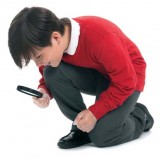Deborah Herridge ducks under the crime scene tape and finds evidence of exciting primary science...
Where once children aspired to the science careers of astronauts, surgeons or vets, now the career of choice (apart from ‘celebrity’) is Crime Scene Investigator. Popularised by many TV shows, CSI is a fascinating and accessible starting point for practical activities in the classroom, and particularly effective in encouraging even the most reluctant young scientists to flex their investigative muscles.
 Searching for evidence…
Searching for evidence…
It was in the late nineteenth century that forensic science, or the science related to law and objects related to a crime, came into its own. The most influential idea came from a French scientist, Edmond Locard, who developed a theory about evidence which said that when a crime is committed the criminal will always leave something at the scene and at the same time take something away with him. This may be a hair, a fingerprint or even a skin cell, but there will be some ‘exchange’ of evidence.
In the primary classroom we can use Locard’s exchange theory as the basis for a host of science investigations involving matching, grouping and classification activities.
 How to ‘lift’ prints…
How to ‘lift’ prints…
At the heart of any crime scene investigation is the skill of detailed observation. Before collecting any evidence the CSI will ‘walk the scene’, taking note of anything that looks out of place, searching for traces of evidence.
One of the most common traces is fingerprints and most children will know that their fingerprint is unique to them.
Fingerprints are very easy to take using an ink pad, the trick being to make sure your fingers don’t get too wet or overloaded with ink and to ‘roll’your finger across some white paper rather than just pressing down. This way you’ll recover the entire print.
Recovering prints can be fun too; this works best on smooth surfaces such as glass or plastic. Rub a small amount of hand lotion or oil into your hands and make a print on your smooth surface. This leaves behind an impression of the tiny raised lines on your hands and fingers, or ‘friction ridges’ as they are referred to by CSIs.
Gently sprinkle some fine powder over the print – this could be powder paint, talc, cocoa powder or anything that is fine enough to stick to the oily residue. Gently blow or brush over the print with a soft brush and it will be revealed. Now you can ‘lift’ the print by pressing a short length or transparent sticky tape over the impression.
As you remove the tape the pattern will be transferred and you’ll capture the print on the tape.
Look carefully at the patterns – can you pick out your own print from those made by the rest of the class? Research common fingerprint patterns: plain and tented arch patterns, loops and whorls. Can you classify the fingerprints of your friends?
Identify different inks…
Perhaps your criminal left a ransom note or demand? If so, the science of chromatography can help us discover which pen the ink came from.
Collect a selection of black felt-tips from different manufacturers. Scribble a blob of ink from each pen about 1 cm from the base of a strip of filter paper. Gently dip the end of the paper into clean water and watch what happens.
As the water is drawn up the paper, the soluble colours in the ink travel upwards and separate. In a black pen these may range from yellow, through urquoise and green to brown and pink.
Test the note in the same way – do any of our suspects’ pens match the profile?
 Eliminate suspects by comparing teeth marks…
Eliminate suspects by comparing teeth marks…
In the case of one hungry burglar, the culprit took a bite out of a piece of cake in his victim’s kitchen; it was to prove his undoing. Police matched the teeth marks on the cake to the thief’s and so proved that he was responsible.
We can take teeth impressions easily using a small Styrofoam plate. Cut the plate into six cake-shaped wedges and put one wedge on top of another. Now cut off about 3 cms from the pointed end and discard these pieces.
Insert the wedge into your mouth and bite down on, but not through, the plate. You should now have an impression of your top and bottom teeth.
Have one child secretly bite into an apple – can we identify who ate the apple from the teeth impressions?
Catch criminals by making a cast…
Perhaps your suspect needed to walk across some damp ground to get to the crime scene? Did he or she leave any footprint impressions in the earth which could connect them to the crime?
When we walk across soft ground our shoes may make a negative mould from which e can take a cast revealing any imperfections or patterns unique to that particular boot or shoe. Scientists use casts to make replicas of the surface of the sole of a shoe, which can then be matched to the culprit.
To make a cast, build a ‘frame’ around the impression to hold the casting material and push the frame into the ground. Rulers taped together are fine so long as you make sure there are no gaps where the casting material could seep out.
A really effective casting material is Dentstone – widely available from internet providers. It mixes easily to a pouring consistency when water is added and sets very quickly.
Compare your cast to the suspect’s shoe. Are there any points of similarity?
Casts can also give us an indication of the height and weight of the person. If the impression is very deep, it’s likely that the person who made it is heavier (or carrying something heavy) than a person making a shallow impression. The length of shoe is important too.
Get the children to measure their height in cms and plot this against the length of their right foot on a class graph. Is there a pattern?
Reaching a verdict…
As scientists, we need to have faith in the evidence we collect. How reliable is our evidence? Do all of the pieces of the puzzle fit or only some? Will our evidence stand up to scrutiny in court? How much trust can we place in our evidence – enough to take away someone’s liberty?
The side effects of teaching music
Ace-Music
Teaching five year olds to talk
Ace-Classroom-Support
5 friendship and emotions intervention ideas
Ace-Classroom-Support
